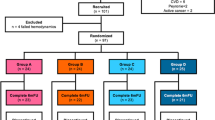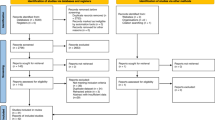Abstract
Low-intensity shockwave therapy (LiST) is an effective treatment for pain reduction in patients with Peyronie’s disease (PD). We aimed to report the long-term results of a previously published randomized, sham-controlled trial on LiST for PD management. For the initial study, 102 patients with stable PD were randomly assigned to six sessions of LiST (n = 51) or sham (n = 51) therapy. All participants were subsequently contacted for an additional evaluation at 3 years after completion of the initial treatment and 63 of them (LiST = 34 and sham therapy = 29) presented for the evaluation. Among them, improvement of pain was reported in 23 participants (LiST = 16, sham = 7, p = 0.005) at 4 weeks and in 22 (LiST = 15, sham = 7, p = 0.031) at 3 years. We detected a mean difference of 2.2 points (95%CI: 0.9–3.5, p = 0.002) in the visual analog pain scale at 4 weeks and a mean difference of 2.5 points (95%CI: 1–4, p = 0.002) at 3 years between the two groups. No treatment-related complications occurred during the sessions or the follow-up period. Regarding the improvement of penile curvature or sexual function, no significant differences between the two groups were observed. Overall, LiST constitutes a safe and effective therapeutic approach for pain management both in the short- and long term.
This is a preview of subscription content, access via your institution
Access options
Subscribe to this journal
Receive 8 print issues and online access
$259.00 per year
only $32.38 per issue
Buy this article
- Purchase on Springer Link
- Instant access to full article PDF
Prices may be subject to local taxes which are calculated during checkout

Similar content being viewed by others
References
Devine CJ, Somers KD, Jordan SG, Schlossberg SM. Proposal: trauma as the cause of the Peyronie’s lesion. J Urol. 1997;157:285–90.
Chung E, Ralph D, Kagioglu A, Garaffa G, Shamsodini A, Bivalacqua T, et al. Evidence-based management guidelines on Peyronie’s disease. J Sex Med. 2016;13:905–23.
Levine LA, Becher EF, Bella AJ, Brant WO, Kohler TS, Martinez-Salamanca JI, et al. Penile prosthesis surgery: current recommendations from the international consultation on sexual medicine. J Sex Med. 2016;13:489–518.
Gao L, Qian S, Tang Z, Li J, Yuan J. A meta-analysis of extracorporeal shock wave therapy for Peyronie’s disease. Int J Impot Res. 2016;28:161–6.
Capogrosso P, Frey A, Jensen CFS, Rastrelli G, Russo GI, Torremade J, et al. Low-intensity shock wave therapy in sexual medicine-clinical recommendations from the European society of sexual medicine (ESSM). J Sex Med. 2019;16:1490–505.
Hatzichristodoulou G, Meisner C, Gschwend JE, Stenzl A, Lahme S. Extracorporeal shock wave therapy in Peyronie’s disease: results of a placebo-controlled, prospective, randomized, single-blind study. J Sex Med. 2013;10:2815–21.
Palmieri A, Imbimbo C, Longo N, Fusco F, Verze P, Mangiapia F, et al. A first prospective, randomized, double-blind, placebo-controlled clinical trial evaluating extracorporeal shock wave therapy for the treatment of Peyronie’s disease. Eur Urol. 2009;56:363–9.
Chitale S, Morsey M, Swift L, Sethia K. Limited shock wave therapy vs sham treatment in men with Peyronie’s disease: results of a prospective randomized controlled double-blind trial. BJU Int. 2010;106:1352–6.
Salonia A, Bettochi C, Carvalho J, Corona G, Jones TH, Kadioğlu A, et al. EAU guidelines on sexual and reproductive health 2020. In: European Association of Urology Guidelines 2020 edition. Arnhem, The Netherlands: European Association of Urology Guidelines Office; 2020. https://uroweb.org/guideline/sexual-and-reproductive-health/.
Nehra A, Alterowitz R, Culkin DJ, Faraday MM, Hakim LS, Heidelbaugh JJ, et al. Peyronie’s disease: AUA guideline. J Urol. 2015;194:745–53.
Goldstein I, Lipshultz LI, McLane M, Hu Y, Xiang Q, Liu G, et al. Long-term safety and curvature deformity characterization in patients previously treated with collagenase clostridium histolyticum for Peyronie’s disease. J Urol. 2020;203:1191–7.
Gelbard MK, Dorey F, James K. The natural history of Peyronie’s disease. J Urol. 1990;144:1376–9.
Bekos A, Arvaniti M, Hatzimouratidis K, Moysidis K, Tzortzis V, Hatzichristou D. The natural history of Peyronie’s disease: an ultrasonography-based study. Eur Urol. 2008;53:644–50.
Schulz KF, Altman DG, Moher D. CONSORT 2010 statement: updated guidelines for reporting parallel group randomised trials. BMJ. 2010;340:c332. CONSORT Group
Hauck EW, Altinkilic BM, Ludwig M, Lüdecke G, Schroeder-Printzen I, Arens C, et al. Extracorporal shock wave therapy in the treatment of Peyronie’s disease. First results of a case-controlled approach. Eur Urol. 2000;38:663–9. discussion 670
Mulhall JP, Schiff J, Guhring P. An analysis of the natural history of Peyronie’s disease. J Urol. 2006;175:2115–8. discussion 2118
Berookhim BM, Choi J, Alex B, Mulhall JP. Deformity stabilization and improvement in men with untreated Peyronie’s disease. BJU Int. 2014;113:133–6.
Capoccia E, Ziegelmann M, Emmerson J, Lankford J, Ofori-Marfoh C, Levine L. Long-term patient-reported outcomes in men with Peyronie’s disease undergoing nonsurgical and nonintralesional injection management. Int J Impot Res. 2021;33:75–81.
Kadioglu A, Küçükdurmaz F, Sanli O. Current status of the surgical management of Peyronie’s disease. Nat Rev Urol. 2011;8:95–106.
Fode M, Østergren PB. Contemporary thoughts on the role of shockwave therapy in Peyronie’s disease. J Sex Med. 2020;17:174–9.
Fojecki GL, Tiessen S, Osther PJS. Extracorporeal shock wave therapy (ESWT) in urology: a systematic review of outcome in Peyronie’s disease, erectile dysfunction and chronic pelvic pain. World J Urol. 2017;35:1–9.
Fode M, Russo GI, Verze P. Therapeutic areas of Li-ESWT in sexual medicine other than erectile dysfunction. Int J Impot Res. 2019;31:223–30.
Srirangam SJ, Manikandan R, Hussain J, Collins GN, O’Reilly PH. Long-term results of extracorporeal shockwave therapy for Peyronie’s disease. J Endourol. 2006;20:880–4.
Amighi A, Eleswarapu SV, Mendhiratta N, Nork JJ, Mills JN. Discontinuation from collagenase clostridium histolyticum therapy for Peyronie’s disease: review and single-center cohort analysis. Sex Med Rev. 2019;7:690–8.
Palmieri A, Imbimbo C, Creta M, Verze P, Fusco F, Mirone V. Tadalafil once daily and extracorporeal shock wave therapy in the management of patients with Peyronie’s disease and erectile dysfunction: results from a prospective randomized trial. Int J Androl. 2012;35:190–5.
Mirone V, Imbimbo C, Palmieri A, Fusco F. Our experience on the association of a new physical and medical therapy in patients suffering from induratio penis plastica. Eur Urol. 1999;36:327–30.
Liu T, Shindel AW, Lin G, Lue TF. Cellular signaling pathways modulated by low-intensity extracorporeal shock wave therapy. Int J Impot Res. 2019;31:170–6.
Krieger JR, Rizk PJ, Kohn TP, Pastuszak A. Shockwave therapy in the treatment of Peyronie’s disease. Sex Med Rev. 2019;7:499–507.
Author information
Authors and Affiliations
Contributions
All authors participated in the drafting, writing, and editing of the manuscript.
Corresponding author
Ethics declarations
Conflict of interest
The authors declare no competing interests.
Additional information
Publisher’s note Springer Nature remains neutral with regard to jurisdictional claims in published maps and institutional affiliations.
Supplementary information
Rights and permissions
About this article
Cite this article
Sokolakis, I., Pyrgidis, N., Lahme, S. et al. Low-intensity shockwave therapy in Peyronie’s disease: long-term results from a prospective, randomized, sham-controlled trial. Int J Impot Res 34, 487–494 (2022). https://doi.org/10.1038/s41443-021-00447-2
Received:
Revised:
Accepted:
Published:
Issue Date:
DOI: https://doi.org/10.1038/s41443-021-00447-2
This article is cited by
-
Long-term experiences with high-energy shock wave therapy in the management chronic phase Peyronie’s disease using two different electromagnetic lithotripters
World Journal of Urology (2024)
-
Updated recommendations on the therapeutic role of extracorporeal shock wave therapy for peyronie’s disease: systematic review and meta-analysis
BMC Urology (2023)
-
A systematic review of non-surgical management in Peyronieʼs disease
International Journal of Impotence Research (2023)



